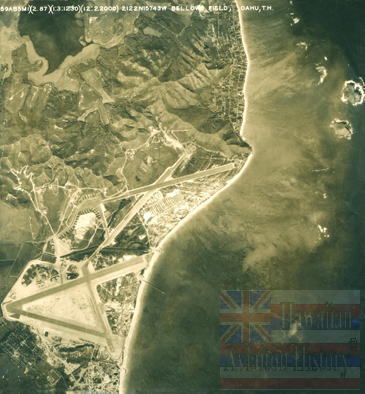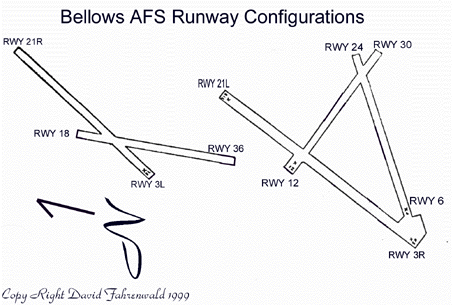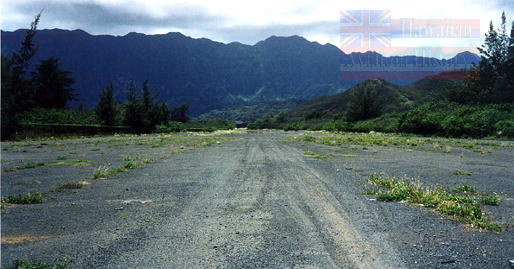Bellows Air Force Station, Hawaii
Bellows AFS is an inactive airfield, established in 1917 by the Presidential Executive Order that created the Waimanalo Military Reservation on land that was leased from the Waimanalo Sugar Plantation. The station covers almost 1500 acres on the windward side of O'ahu near the southeast corner of the island. It is about 6 miles southeast of the Kaneohe MCBH and about 6 miles west of Makapu Point.
The land at which Bellows AFS now occupies is the site of an ancient native Hawaiian community. Many artifacts, some of which are among the oldest in the Hawaiian Islands, have been found there. Evidence of the Waimanalo Sugar Plantation is still evident in the scattered wild sugarcane and the graves of immigrant workers. Many of the graves are now unmarked because of deterioration but some are still visible. There is a rumor that some of the famous Japanese American 442nd are buried at Bellows but that seems to be a myth.
Just before the infamous date of December 7th, 1941, Bellows was home to the 86th Observation Squadron and the a temporary home and training area for new recruits from the 44th Pursuit Squadron. Bellows was an outlying field and did not receive nearly the attention Hickam Field did. In 1941 only one runway existed. With the outbreak of war Bellows was transformed almost overnight into an important facility where aircraft were prepared for their duty in the Pacific Theater. Hundreds of men and aircraft flowed through Bellows requiring more runways and facilities.
The 86th Observation Squadron has a long and varied history beginning Aug. 17, 1917, as the 86th Aero Squadron. It served as part of the zone of advance in France during the latter part of World War I. Then in 1935, it was an observation squadron operating as part of the Air Corps Tactical School at Maxwell Field, Alabama. Beginning Dec. 7, 1941, the squadron conducted patrols over the Hawaiian islands.

Bellows Air Force Base 1949
The squadron then switched yet again. As a combat mapping squadron, the unit's aircrews flew over Japanese held islands photographing and mapping the terrain and enemy positions. The 86th prepared the way for the taking of the Marshall Islands, Wake, Saipan. Guam, and Iwo Jima. Finally, in 1944, the squadron made the first photographic mosaics of Tokyo. The squadron was redesigned as the 43rd Reconnaissance Squadron (long range photographic) in 1945 then was deactivated in 1946. In January 1954, the 43rd was again activated, this time at Shaw Air Force Base, South Carolina. The squadron's aircrews flying RB-57 and RB-66 aircraft, accomplished a bight photographic mission. The unit was deactivated in 1959.
Redesigned, the 43rd Electronic Combat Squadron, the unit was activated June 6, 1986, at Sembach Air Base, Germany. It served in Europe until 1991, then came to Davis-Monthan AFB, Arizona and the 355th Wing or the 12th Air Force, May 1, 1992, as the sister squadron to the 41st. The 43rd earned a combat streamer for its duties in World War I and six more for missions flown in the Pacific during World War II.
Following the closure of the runway complex, Bellows Air Force Base became Bellows Air Force Station and the home to a NIKE missile site and a Communications Facility. The Communication Transmitter Facility was a large Air Force communications antenna site. The site was operated and maintained by the 1957th Communications Group. The transmitter facility, established in 1956, was a major communications network which included tie-ins with the presidential communication network. There were 27 high frequency antennae, both rotateable and fixed, occupying 577 acres. The facility was decommissioned in the early 1990's or the late 1980's. This communications network was one of the reasons the runways at Bellows were allowed to deteriorate and also hindered attempts to make at least part of Bellows a reliever or general aviation airport.

Bellows Air Force Base Main Gate 1949
Bellows has five inactive runways. Three southern runways (6/24, 12/30, and 3R/21L) and two northern runways (18/36 and 3L/21R). These runways are severely deteriorated and not usable by fixed wing aircraft. The runways were closed in 1958 and are only used by helicopters from Kaneohe Marine Corps Base Hawaii.
Due to the deactivation of the airfield in 1958 and the over-grown condition of the runways and taxiways, no aircraft are based at Bellows. However, the Marines still use Bellows for some limited helicopter operations. The Marine Corps also uses the beach and parts of Bellows as a training area for amphibious operations on a frequent basis. In fact, Bellows is scheduled to be transferred to the Marine Corps as soon as environmental cleanup efforts are completed. Bellows also serves as a recreation area for military personnel. There are cabins located around the beach front and camping grounds. There has been some effort made by native Hawaii groups and Hawaii Representative Neil Abercrombie (D) to have Bellows returned to the Hawaiian people for homesteads but in the interests of national security Bellows will remain a military installation.

Main Gate to the Nike Communications Site

Runway Configuration

View of Runway 21R

Runway from Lanikai Hillside